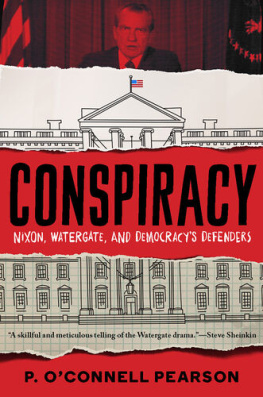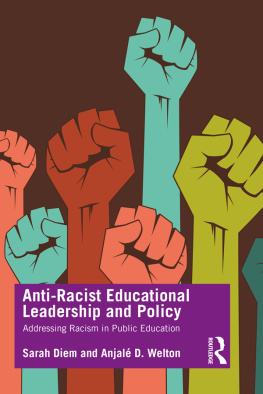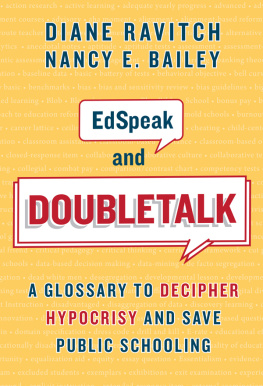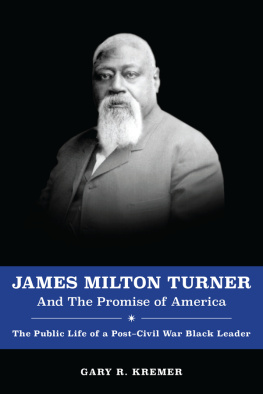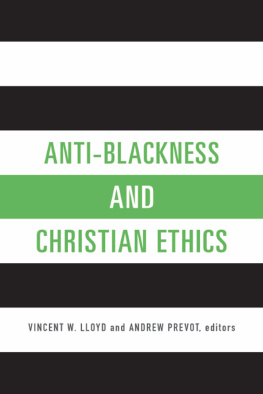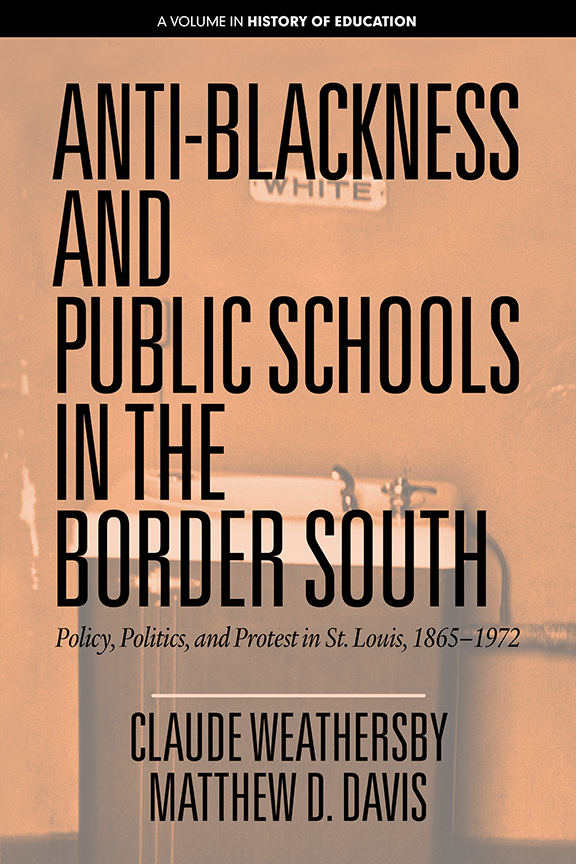_________________________________________
Anti-Blackness and Public Schools in the Border South
______
A volume in
History of Education
Jared R. Stallones, Series Editor
___________________________________________
Anti-Blackness and Public Schools in the Border South
Policy, Politics, and Protest in St. Louis, 18651972
_______
Claude Weathersby
Independent Scholar
Matthew D. Davis
University of MissouriSt. Louis
INFORMATION AGE PUBLISHING, INC.
Charlotte, NC www.infoagepub.com
Library of Congress Cataloging-in-Publication Data
A CIP record for this book is available from the Library of Congress
http://www.loc.gov
ISBN: 978-1-64113-746-1 (Paperback)
978-1-64113-747-8 (Hardcover)
978-1-64113-748-5 (ebook)
Copyright 2019 Information Age Publishing Inc.
All rights reserved. No part of this publication may be reproduced, stored in a
retrieval system, or transmitted, in any form or by any means, electronic, mechanical,
photocopying, microfilming, recording or otherwise, without written permission
from the publisher.
Printed in the United States of America
Foreword
T he History of Education book series is sponsored by the Organization of Educational Historians (OEH). OEH was founded in 1965 as the Midwest History of Education Society (MHES) by Professor Kenneth Beasley of Northern Illinois University and Professor Gerald Gutek from Loyola University in Chicago. The two met at the 1964 annual meeting of the Midwest Philosophy of Education Society and realized the need for a regional history of education society in the Midwest. They invited historians of education at Midwestern colleges and universities to meet at Loyola University Chicago in Spring 1965 to organize the society. Ten historians gathered in a seminar room at Loyolas Lewis Towers, shared papers, and agreed to convene the first meeting of the Midwest History of Education Society that fall. For the next 3 decades, the society met annually at Loyola University on the last weekend in October.
The MHES operated for many years without a mission statement, a constitution, by-laws, or dues. The society was simply a convocation for historians of education. It had three officers who were elected for 1-year terms at the annual meeting: a president to preside over the annual meeting, a vice-president to organize the program, and a secretary to keep minutes and send out the annual notice of the meeting. With no dues and no funds, there was no need for a treasurer. The annual meeting consisted of papers, an evening banquet address, and a short business meeting. The meetings were informal with no official respondents to the papers but a great deal of lively conversation over the presentations. In 1973, under the leadership of Professor Edward Rutkowski from the University of Northern Iowa, the society published its first Annual Proceedings of the Midwest History of Education Society .
By the late 1980s, the society had grown from its early beginnings and begun to attract members from other regions of the country. A more formal arrangement was needed, and the society adopted a constitution, by-laws, and began collecting dues. While maintaining the Societys openness, the changes helped to ensure that it would grow into a true professional organization for scholars of education history. In 2002, the Annual Proceedings became a peer-reviewed journal, the American Educational History Journal. Then, in December 2008, the membership voted to replace the name Midwest History of Education Society with the name Organization of Educational Historians. The Organization continues to meet in Chicago each fall and remains an informal, collegial venue for the exchange of ideas about the history of education.
The best historical tradition investigates the past to inform vital issues of the day. This volume is no different. The authors probe the long history of African-American activism on behalf of educational equity for their communities. In this case, the lens is turned on St. Louis, a hub city that has long connected the South, West, and Midwest. Following an overview of education history through the African-American lens, the authors detail developments in St. Louis after 1865. The story reveals consistent White antipathy to the educational aspirations of African Americans, but just as consistent activism and advocacy by African Americans on their own behalf. It is a story of neglect, duplicity, and hostility, but also of courageous individuals and forward thinking institutions. The sum is a richly textured narrative of the struggle for educational equity in one community with resonance for all communities that seek social justice in their education systems.
Jared R. Stallones
Series Editor
Introduction
A frican American historians like John Hope Franklin, W. E. B. Du Bois, and Carter G. Woodson, committed to the concept of race uplift to improve the social and educational conditions of Black people, struggled to maintain objectivity in historical and social science research of the Black communities in which they reported. As the mindset of the White community grappled with the educability of Black people over the years, their slow acceptance of education for Blacks transferred to challenges of objectivity in African American historian research whose research focuses on the education of Black people. Objectivity has long been the foundation of research in the physical and social sciences (Alridge, 2003, p. 25). Peter Norvick (1988) argued, The objective historians role is that of a neutral, or disinterested, judge; it must never degenerate into that of advocate or, even worse, propagandist (p. 2). The academy should not mitigate the efforts of Black scholars related to the question of contaminated research because of the objectivity issue.
The authors of this work made a concerted effort to achieve objectivity in spite of the lead authors St. Louis background, long-time resident of St. Louis City, and graduate of its St. Louis Public Schools district, which might run the risk of being too subjective and less scholarly (Collins, 2000). According to Vincent Harding (1974), the academy has asked Black scholars to offer sympathetic but hard Black analysis concerning the nature and effectiveness of the sometimes strange and valiant approaches to the Black Freedom struggle which have arisen out of our own generation.
This narrative examined the Black Freedom struggle for equitable education in St. Louis, Missouri, via the St. Louis Public School district virtually from the inception of the school district. Unlike other public school districts in and around the City of St. Louis, Missouri, the St. Louis Public Schools district encompasses the entire City of St. Louis only. The public school districts boundaries do not exceed the St. Louis City boundaries. Dissimilar from other public school districts in the St. Louis metropolitan area that encompass several municipalities or parts of smaller municipalities, the St. Louis Public Schools district began and remained as the most influential public school district in the region from the mid-1800s through the major part of the 20th century.
Missouris original state constitution, created in 1820 with its entry into the Union, reflected the states slaveholding status. Missouris beginnings as a slave state influenced the development of the St. Louis Public Schools district. Prior to the Civil War, the State of Missouri had outlawed the education of slaves with State legislation in 1847. However, a sense of educational activism accompanied other issues of self-determinism free and formerly enslaved Blacks quest for education in Missouri. Enslaved people risked their lives to learn how to read and write because they realized the power of literacy. Educational attainment provided the way for Blacks to rise above the countrys predetermined station in life for them. Blacks reached for something better for themselves and future generations. Without coming together to advocate for improvements and changes in their educational condition, Blacks would have made little progress.


